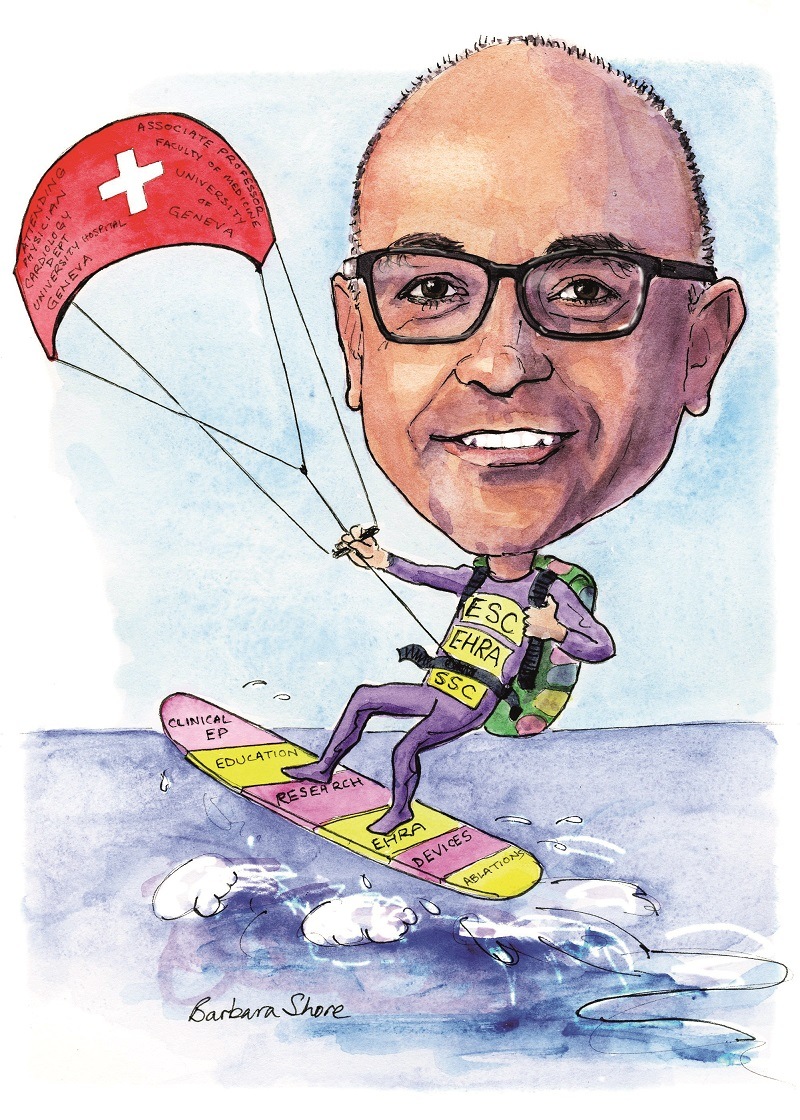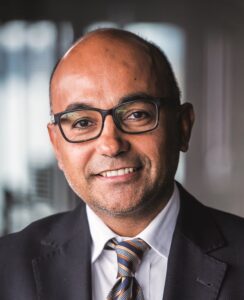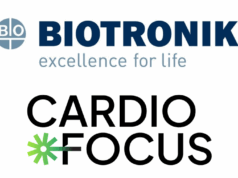 During his studies Haran Burri was fascinated by the simplicity of an ECG providing a vast amount of information on cardiac functions. This drew him towards a career in cardiology and electrophysiology. He is an associate professor at the University Hospital of Geneva where he is responsible for the Cardiac Pacing programme and is also actively involved in interventional electrophysiology. He speaks to Cardiac Rhythm News about various aspects of his career.
During his studies Haran Burri was fascinated by the simplicity of an ECG providing a vast amount of information on cardiac functions. This drew him towards a career in cardiology and electrophysiology. He is an associate professor at the University Hospital of Geneva where he is responsible for the Cardiac Pacing programme and is also actively involved in interventional electrophysiology. He speaks to Cardiac Rhythm News about various aspects of his career.
Why did you decide to become a doctor and why, in particular, did you decide to specialise in electrophysiology?
I was intrigued from an early age by how our body works, which was one of the reasons I went into medicine. During my studies, I was fascinated by how simple line drawings of an electrocardiogram tracing could provide so much information about cardiac function. The ECG therefore drew me towards cardiology and later to electrophysiology. In addition to the exciting technical developments that we have witnessed over the last years, electrophysiology and device therapy are extremely varied fields that combine aspects such as clinical judgment, non-invasive and invasive diagnostics, drug therapy, device programming, catheter manipulation and surgical skills. I do not believe that there are many fields in medicine which are so varied.
Who have been your career mentors?
I am very grateful to Marc Zimmermann whom I have known since my internship in Geneva. In addition to conveying his mastery in electrophysiology, he has been a role model and a constant source of guidance and friendship. I am indebted to Philippe Chevalier, with whom I spent a fellowship year in Lyon, and to Dipen Shah, who taught me the ropes of atrial fibrillation ablation when he moved over from Bordeaux to Geneva. I am also grateful to Hein Heidbuchel, the current European Heart Rhythm Association (EHRA) president, who has entrusted me with important tasks, such as chairing the education committee and currently the congress scientific programme committee.
What has been the most important development in the field of electrophysiology during your career?
There have been many developments but the one I consider most important is electro-anatomical mapping, which allows us to tackle complex arrhythmias and also dramatically reduces fluoroscopic exposure. Remote monitoring has been a milestone in the domain of device therapy.
What has been the biggest disappointment where you had hoped something would change practice but did not?
Alternative sites for ventricular pacing held the promise of being more physiological and less detrimental in terms of ventricular function. Pacing the left ventricle or the interventricular septum have unfortunately not been found to be any better than pacing the right ventricular apex. However, I still implant pacing leads on the septum to avoid perforation.
Of the research you have been involved with, which do you think will have the greatest impact on clinical practice?
It is indeed a great satisfaction when one’s research does not simply serve to lengthen one’s list of publications, but has an impact on treating patients. Colleagues have mentioned that work I have done on techniques for axillary vein access and for septal lead placement have been useful in their own practise.
What are your current research interests?
I believe that His bundle pacing may be the holy grail we have been searching for as an alternative to ventricular pacing and may even restore electrical synchrony more efficiently than biventricular pacing. I am currently involved in research in various aspects of His bundle pacing such as His-optimised cardiac resynchronisation therapy (CRT) and also regarding device programming.
 As you are the 2018–2020 scientific programme chairperson for EHRA and EHRA 2019 being the second annual edition of the congress, what were the challenges of turning a biannual meeting (as EHRA was previously) into an annual one?
As you are the 2018–2020 scientific programme chairperson for EHRA and EHRA 2019 being the second annual edition of the congress, what were the challenges of turning a biannual meeting (as EHRA was previously) into an annual one?
The scientific programme committee is elected for two years, and we will now be busy with this task during both these years. Constructing an attractive programme requires a lot of hard work and fresh ideas. I am fortunate to be helped by Katja Zeppenfeld who co-chairs the committee and we have a great team of colleagues who actively contribute.
What are the core themes of the 2019 meeting and what do you think the highlights will be?
Innovation is the theme of EHRA 2019, and we will be emphasising this in our sessions by covering new techniques and technologies which are relevant to our clinical practise. We will also be hosting an EHRA innovations award to promote the work of inventors. We will be organising for the first time three EHRA “championships” to challenge participants with interpretation of ECGs, device tracings and electrophysiology tracings. Also, we have had a record number of abstract submissions, which has allowed us to choose high-quality scientific content for the rapid fire and poster sessions.
Why should physicians be interested in innovation?
Because one should always strive for greater efficacy and safety.
Given we are now living in the digital age with so much information online, why is it valuable to attend conferences such as the EHRA in person?
You could also ask yourself why one still travels or goes to museums as one has Google Images! Despite the plethora of e-learning for continued medical education, I strongly believe that in-person exchange with colleagues will always remain a valuable and stimulating experience which cannot be otherwise replaced.
Social media platforms such as Twitter and LinkedIn are increasingly being used as a source of medical communication. What do you think are the pros and cons of using social media for medical communication?
I am already struggling to keep up with my daily deluge of emails and would simply not be able to handle social media. No doubt these means of communication are useful for spreading information, but they should not be intrusive. Triage of information and quality control of content are also issues.
What has been your most memorable case?
I had implanted a 12-year-old girl with an implantable cardioverter-defibrillator (ICD) for aborted sudden death due to coronary artery spasms, who kept having recurrences of spasms with ventricular arrhythmias and ICD shocks despite trying different medical therapies and even sympathectomy. There was simply nothing that I or my colleagues could do to help her, and she ended up with a heart transplant. As parents, paediatric cases affect us the most emotionally.
What advice would you give to someone just starting their career in the field of electrophysiology?
One has to be passionate about what one does, as there is much to learn and it will take a lot of effort. Do not bluff, because it will be hard to take you seriously again if you are not sincere. As you progress, always keep an open mind about how best to do things. And finally, always remember that you are treating a person and not just an arrhythmia.
Outside of medicine, what are your hobbies and interests?
Travelling with my family allows me to enjoy time with them that is otherwise denied during my working days. I enjoy the speed of downhill skiing and of kitesurfing, which provide me with my adrenalin boosts as well as experiencing the elements of the mountains and the sea. I can also on occasion be spotted struggling in the last quintile of mid-distance running races.
Fact File
Current appointments
- Attending physician, Cardiology Department, University Hospital, Geneva, Switzerland
- Associate professor, Faculty of Medicine, University of Geneva, Switzerland
Medical training
- 2017: Associate professor
- 2015: Assistant professor
- 2007: EHRA competency in interventional electrophysiology
- 2006: EHRA competency in cardiac pacing
- 2001: FMH (Swiss specialisation) in Cardiology
- 1992: Swiss Federal Medical Diploma (1992)
Society membership
- European Society of Cardiology
- Education Board
- European Heart Rhythm Association (EHRA) Scientific Congress Committee; chairman 2018–2020
- EHRA Education Committee (2009-2015); chairman 2013-2015
- Swiss Society of Cardiology Working group in Electrophysiology; president 2015–2017
- EHRA Health Economics Committee (2010-2011)
Publications
- Burri H, et al. Device programming for His bundle pacing. Circulation Arrhythmias & Electrophysiology 2019
- Leclercq C, Burri H, et al. CRT non-responder to responder conversation rate in the more response to cardiac resynchronisation therapy with MultiPoint Pacing (MORE-CRT MPP) study: Results from phase l. Eur Heart J 2019
- Burri H, et al. Risk stratification of cardiovascular and heart failure hospitalisations using integrated device diagnostics in patients with cardiac resynchronisation therapy defibrillator; Europace 2018; 20: e69–e77
- Burri H, et al. Low risk of electromagnetic interference between smartphones and contemporary implantable cardioverter defibrillators. Europace 2016;18(5): 726-31
- Burri H, et al. The EHRA book on pacemaker, ICD and CRT troubleshooting. Oxford University Press; 2015









